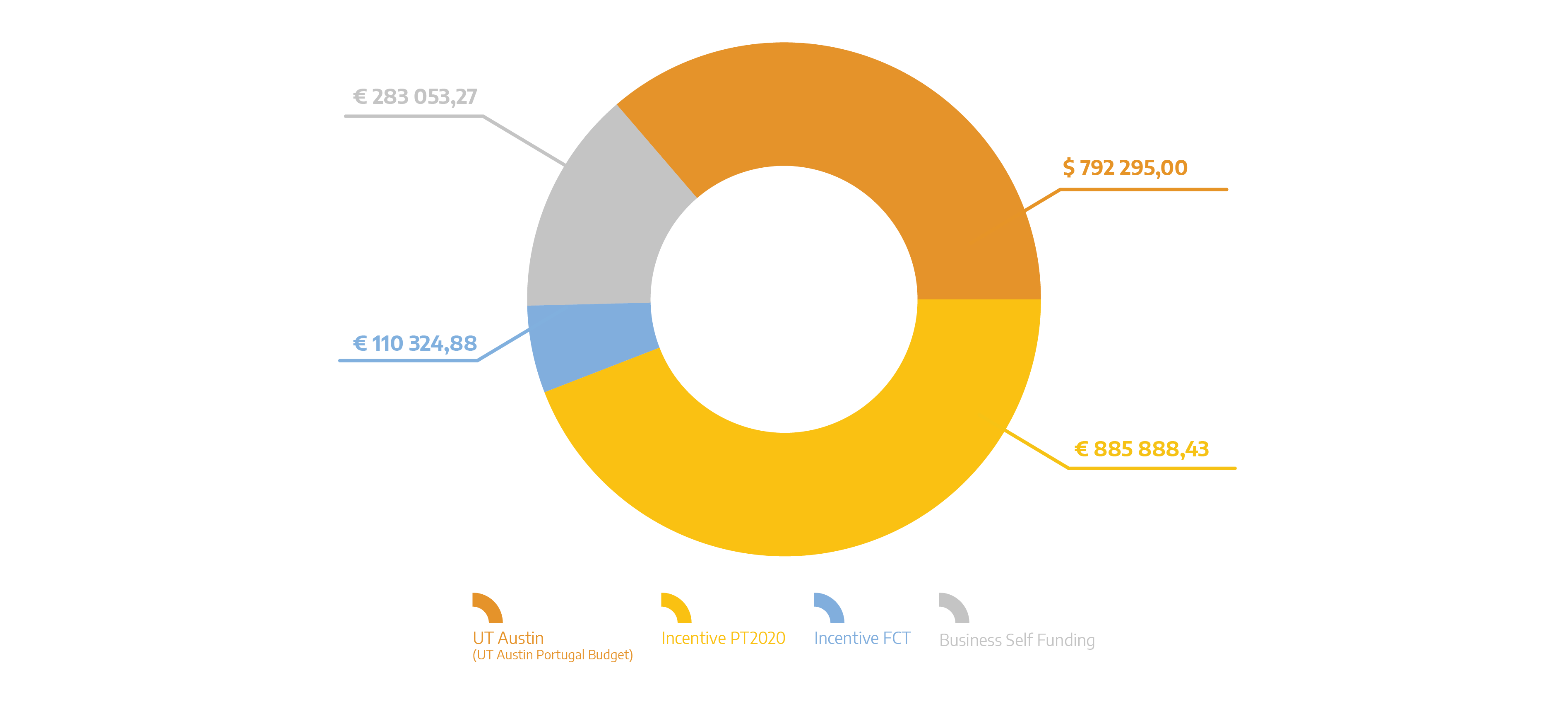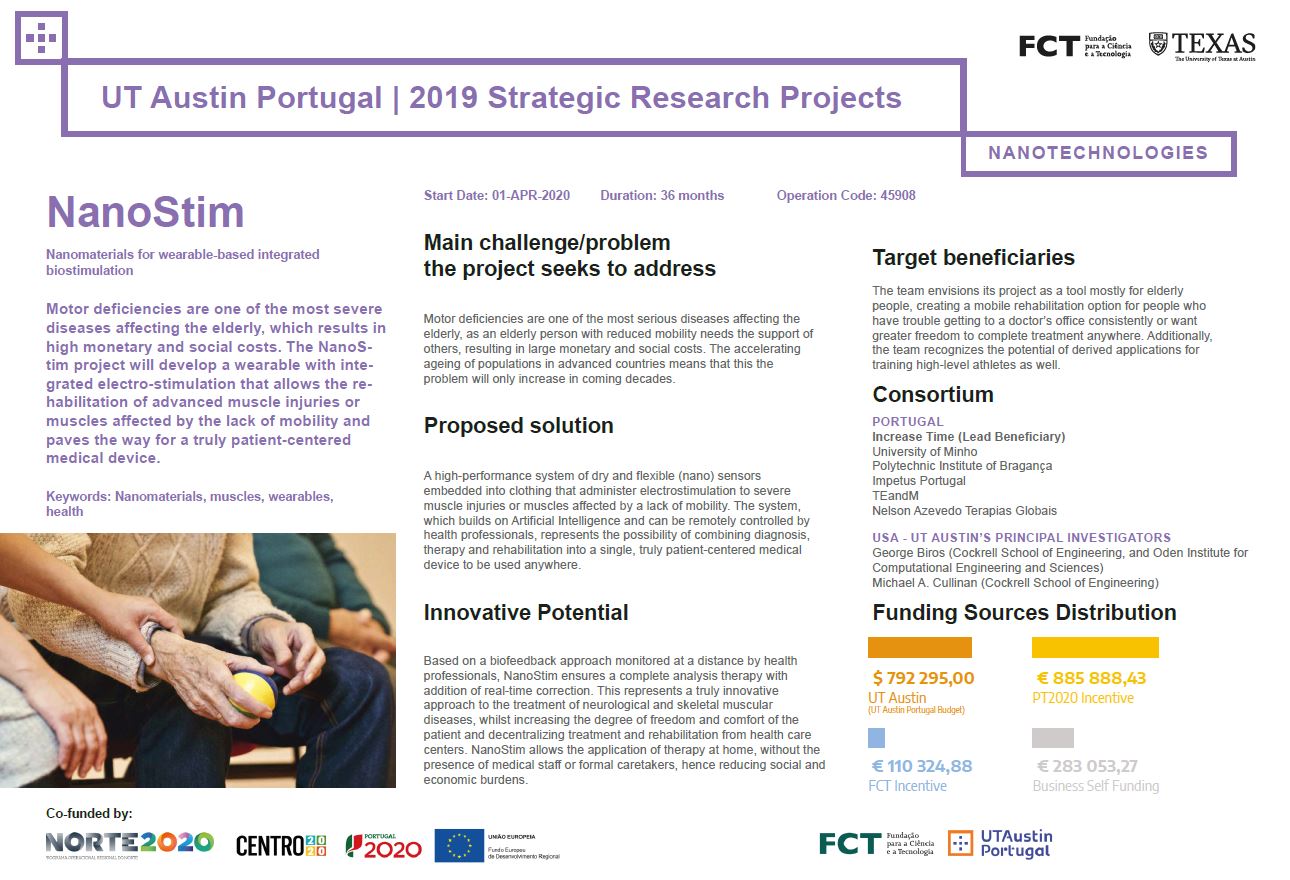Summary
Motor deficiencies are one of the most serious diseases affecting the elderly, which can result in large monetary and social costs. The NanoStim project will develop a wearable with integrated electro-stimulation that allows the rehabilitation of advanced muscle injuries and/or lack of mobility.
Based on a biofeedback approach monitored at a distance by health professionals, NanoStim will proceed to rehabilitate by electrostimulation after the interpretation of an electromyographic signal. The ability to shape such important properties as electrical conductivity or mechanical toughness on a nano scale, coupled with the artificial creation of a spinal cord by Artificial Intelligence (AI), ensures a complete analysis therapy with addition of real-time correction, representing a unique evolution in the treatment of neurological and skeletal muscular diseases.
The NanoStim project, by creating a high-performance system of dry and flexible (nano) sensors based on thin films with custom (nano) structures and allowing remote control by health professionals, represents the possibility of combining diagnosis, therapy and rehabilitation into a single, truly patient-centered medical device to be used anywhere, freeing the health centers and increasing the degree of freedom and comfort of the patient.
Expected Outcomes
- Dual-purpose, nanomaterial-based electrodes integrated in wearables, the creation of the AI that will control it, and the testing of the integrated device under real-world conditions;
- A commercial device for market uptake. Envisaged business model includes selling the device directly to the most relevant stakeholders (end users such as patients suffering from muscle conditions and champions such as senior care homes, and hospitals);
- 5 scientific papers, at least, based on the project work.
| Start Date – End Date: | April 1, 2020 – March 31, 2023 June 30, 2023 |
| Scientific Area: | Nanotechnologies |
| Keywords: | Nanomaterials, muscles, wearables, health |
| Website: | https://nanostim.pt |
| Lead Beneficiary (PT): | Increase Time |
|
Co-beneficiaries:
|
Universidade do Minho Instituto Politécnico de Bragança Impetus Portugal TEandM Nelson Azevedo Terapias Globais |
| PIs at UT Austin: | Dr. George Biros (Cockrell School of Engineering, Walker Department of Mechanical Engineering, Oden Institute for Computational Engineering and Sciences, UT Austin) Dr. Michael A Cullinan (Cockrell School of Engineering, Walker Department of Mechanical Engineering, Oden Institute for Computational Engineering and Sciences, UT Austin) |
| Total Eligible Investment (PT): | 1 279 266,58 EUR |
| Total Eligible Investment (US): | 792 295,00 USD |
| Funding Sources Distribution: |

Papers and Communications
- Lopes, C., Rodrigues, M. S., Ferreira, A., Macedo, F., Borsan, I., Gabor, C., Pop, M.-A., Alves, E., Barradas, N. P., Munteanu, D., & Vaz, F. (2023). The influence of the nanostructure design on the optical, electrical and thermal properties of TiNx thin films prepared by reactive magnetron sputtering. In Materials Chemistry and Physics (Vol. 306, p. 127981). Elsevier BV. https://doi.org/10.1016/j.matchemphys.2023.127981
- Lopes, C., Veloso, H., Hayes, M., Cullinan, M. A., & Vaz, F. (2023). Nanostructured (Ti,Cu)N Dry Electrodes for Advanced Control of the Neuromuscular Activity. In IEEE Sensors Journal (Vol. 23, Issue 4, pp. 3629–3639). Institute of Electrical and Electronics Engineers (IEEE). https://doi.org/10.1109/jsen.2022.3232264
- Conselheiro, R., Lopes, C., Azevedo, N., Leitao, P., Agulhari, C., Veloso, H., Vaz, F., Gonçalves, J., Franco, T., & Sestrem, L. (2022). Titanium Based Dry Electrodes for Biostimulation and Data Acquisition. In Distributed Computing and Artificial Intelligence, 19th International Conference (pp. 111–120). Springer International Publishing. https://doi.org/10.1007/978-3-031-20859-1_12
- Franco, T., Henriques, P. R., Alves, P., Pereira, M. J. V., Sestrem, L., Leitao, P., & Silva, A. (2022). myHealth: a Mobile App for Home Muscle Rehabilitation. In 2022 IEEE 10th International Conference on Serious Games and Applications for Health(SeGAH). 2022 IEEE 10th International Conference on Serious Games and Applications for Health(SeGAH). IEEE. https://doi.org/10.1109/segah54908.2022.9978561
- Franco, T., Sestrem, L., Henriques, P. R., Alves, P., Varanda Pereira, M. J., Brandão, D., Leitão, P., & Silva, A. (2022). Motion Sensors for Knee Angle Recognition in Muscle Rehabilitation Solutions. In Sensors (Vol. 22, Issue 19, p. 7605). MDPI AG. https://doi.org/10.3390/s22197605
- Franco, T., Henriques, P. R., Alves, P., Varanda Pereira, M. J., Pedrosa, T., Silva, F., Leitão, P., & Oliveira, L. (2022). System Architecture for Home Muscle Rehabilitation Treatment. In Information Systems and Technologies (pp. 305–315). Springer International Publishing. https://doi.org/10.1007/978-3-031-04829-6_27
- Sestrem, L., Kaizer, R., Gonçalves, J., Leitão, P., Teixeira, J., Lima, J., Franco, T., & Carvalho, J. (2022). Data Acquisition, Conditioning and Processing System for a Wearable-based Biostimulation. In Proceedings of the 15th International Joint Conference on Biomedical Engineering Systems and Technologies. 15th International Conference on Biomedical Electronics and Devices. SCITEPRESS – Science and Technology Publications. https://doi.org/10.5220/0011002300003123
- Franco, T., Henriques, P. R., Alves, P., & Pereira, M. J. V. (2022). Approaches to Classify Knee Osteoarthritis Using Biomechanical Data. In Communications in Computer and Information Science (pp. 417–429). Springer International Publishing. https://doi.org/10.1007/978-3-030-91885-9_31
- Lopes, C., Fiedler, P., Rodrigues, M. S., Borges, J., Bertollo, M., Alves, E., Barradas, N. P., Comani, S., Haueisen, J., & Vaz, F. (2021). Me-Doped Ti–Me Intermetallic Thin Films Used for Dry Biopotential Electrodes: A Comparative Case Study. In Sensors (Vol. 21, Issue 23, p. 8143). MDPI AG. https://doi.org/10.3390/s21238143
E-Posters
2020 Annual Conference (pdf.)

In The News
Co-funded by:
